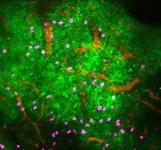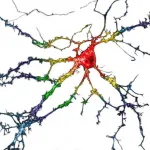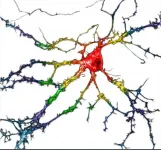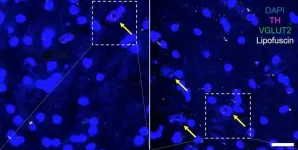INFORMATION:
About the Alliance
The Alliance of Bioversity International and the International Center for Tropical Agriculture (CIAT) delivers research-based solutions that harness agricultural biodiversity and sustainably transform food systems to improve people's lives. Alliance solutions address the global crises of malnutrition, climate change, biodiversity loss, and environmental degradation.
The Alliance is part of CGIAR, a global research partnership for a food-secure future.
http://www.bioversityinternational.org http://www.ciat.cgiar.org http://www.cgiar.org
El Niño can help predict cacao harvests up to 2 years in advance
Long-term weather data is absent in many places, complicating rain predictions for crops. Researchers found that the El Niño climate cycle can be a reliable substitute for weather data
2021-04-28
(Press-News.org) When seasonal rains arrive late in Indonesia, farmers often take it as a sign that it is not worth investing in fertilizer for their crops. Sometimes they opt out of planting annual crops altogether. Generally, they're making the right decision, as a late start to the rainy season is usually associated with the state of El Niño Southern Oscillation (ENSO) and low rainfall in the coming months.
New research published in the Nature journal Scientific Reports shows that ENSO, the weather-shaping cycle of warming and cooling of the Pacific Ocean along the Equator, is a strong predictor of cacao harvests up to two years before a harvest.
This is potentially very good news for smallholder farmers, scientists, and the global chocolate industry. The ability to predict harvest sizes well in advance could shape on-farm investment decisions, improve tropical crop research programs, and reduce risk and uncertainty in the chocolate industry.
Researchers say that the same methods - which pair advanced machine learning with rigorous, short-term data collection on farmer practices and yields - can apply to other rain-dependent crops including coffee and olives.
"The key innovation in this research is that you can effectively substitute weather data with ENSO data," said Thomas Oberthür, a co-author and business developer at the African Plant Nutrition Institute (APNI) in Morocco. "Any crop that shares a production relationship with ENSO can be explored using this method."
About 80 percent of global cropland depends on direct rainfall (as opposed to irrigation), accounting for almost 60 percent of production. But rainfall data is sparse and highly variable in many of these regions, making it difficult for scientists, policymakers and farmers groups to adapt to the vagaries of the weather.
No weather data? No problem
For the study, researchers used a type of machine learning that did not require weather records for the Indonesian cacao farms that participated in the research.
Rather, they relied on data on fertilizer application, yields and farm type, which they plugged into a Bayesian Neural Network (BNN) and found that ENSO phases predicted 75 % of the variation in yields.
In other words, the sea-surface temperature of the Pacific accurately predicted cacao harvests in a large majority of cases for the farms in the study. In some cases, accurate predictions were possible 25 months before the harvest.
For the uninitiated, a model that can accurately predict 50% of yield variation is usually cause to celebrate. And such long-range predictive accuracy for crop yields crops is rare.
"What this allows us to do is superimpose different management practices - such as fertilization regimes - on farms and deduce, with a high level of confidence, those interventions that work," said James Cock, a co-author and emeritus researcher at the Alliance of Bioversity International and CIAT. "This is a whole paradigm shift toward operational research."
Cock, a plant physiologist, said that while randomized control trials (RCTs) are generally considered the gold standard in research, these are extremely costly and consequently often impossible to perform in developing tropical agricultural areas. The approach used here is much lower cost, requires no expensive collection of weather records and provides useful guidelines on how to better manage crops under variable weather.
Ross Chapman, a data analyst and the study's lead author, explained some of the key benefits of machine learning methods over conventional data analysis approaches:
"The BNN modeling differs from standard regression modeling because the algorithm takes input variables, such as sea-surface temperature and farm type, and then automatically 'learns' to recognize responses in other variables, such as crop yield," Chapman said. "The learning process uses the same fundamental process that the human mind learns to recognize objects and patterns from real-life experience. In contrast, standard models require manual supervision of different variables via human-generated equations."
The value of shared data
While machine learning may promise better crop yield predictions in the absence of weather data, scientists - or farmers themselves - still need to accurately collect certain production information and have that data readily available if machine-learning models are going to work.
In the case of the Indonesian cacao farms in the study, farmers had been part of a major chocolate company's training program on best practices. They kept track of inputs such as fertilizer application, freely shared that data for analysis, and an organization with a local presence, the International Plant Nutrition Institute (IPNI), kept tidy records for researchers to use.
In addition, scientists had previously divided their farms into ten similar groups, where topography and soil conditions were similar. The researchers used data on harvests, fertilizer applications and yields from 2013 to 2018 to build their model.
The knowledge gained by cacao growers gives them confidence on how and when to invest in fertilizers. The agronomic skills this vulnerable group acquired shields them against a loss in their investment, which typically occurs when weather is adverse.
Thanks to their collaboration with the researchers, now their knowledge can be, in a way, shared with growers of other crops in other regions of the world.
"This research could not have happened without dedicated farmers, IPNI and a strong farmers' support organization, Community Solutions International, to pull everyone together," Cock said, emphasizing the importance of multidisciplinary collaboration and balancing stakeholder's different needs.
"What scientists want is to know why something happens," he said. "Farmers want to know what works."
APNI's Oberthür said strong predictive modeling could benefit both farmers and researchers, and fuel further collaboration.
"You need to have tangible results if you're a farmer who is also collecting data, which is a lot of work," Oberthür said. "This modeling, which can provide farmers with beneficial information, may help incentivize data collection since farmers will see that they are contributing to something that provides benefits to them on their farms."
ELSE PRESS RELEASES FROM THIS DATE:
Study finds green spaces linked to lower racial disparity in COVID infection rates
2021-04-28
CHAMPAIGN, Ill. -- A higher ratio of green spaces at the county level is associated with a lower racial disparity in coronavirus infection rates, according to a new study. It is the first study to report the significant relationship between the supply of green spaces and reduced disparity in infectious disease rates.
The research team included William Sullivan, a landscape architecture professor at the University of Illinois Urbana-Champaign, and was led by Bin Jiang, a landscape architecture professor at The University of Hong Kong who received his Ph.D. at Illinois, and Yi Lu, an architecture professor at City University of Hong Kong. They reported their findings in the journal Environment ...
The science of picky shoppers
2021-04-28
UNIVERSITY PARK, Pa. -- There are hard-to-please customers in almost every industry, with certain people being picky about which clothes, houses and even romantic partners they will consider.
A new series of studies has found that shopper pickiness can go beyond shopping for the "best" option. The researchers define what it means to be "picky" and also developed a scale for measuring shopper pickiness.
Margaret Meloy, department chair and professor of marketing at Penn State, said the findings could help companies devise the best strategies for satisfying their pickier customers.
"If a company knows they have a lot of picky customers, they may need to change the way they reward salespeople or dedicate specific salespeople to their pickiest customers, because ...
The diploid genome assemblies in marmoset shows huge variations
2021-04-28
In collaboration with VGP, the research group has published a research paper in Nature on platypus and echidna genomes early this year (see report in the right column). In the Nature current special issue, the research group published another study on the genome of the common marmoset, an important primate model for neurodegenerative diseases, drug development and other biomedical research.
The genome includes two sets of chromosomes, one inherited from the mother, the other from the father. In traditional genome sequencing efforts including the human genome project, the sequencing only produced a mosaic reference ...
Soil bacteria evolve with climate change
2021-04-28
While evolution is normally thought of as occurring over millions of years, researchers at the University of California, Irvine have discovered that bacteria can evolve in response to climate change in 18 months. In a study published in the Proceedings of the National Academy of Sciences, biologists from UCI found that evolution is one way that soil microbes might deal with global warming.
Soil microbiomes - the collection of bacteria and other microbes in soil - are a critical engine of the global carbon cycle; microbes decompose the dead plant material to recycle nutrients back into the ecosystem and release carbon back into the atmosphere. Multiple environmental factors influence the composition and functioning of soil microbiomes, ...
Stress slows the immune response in sick mice
2021-04-28
The neurotransmitter noradrenaline, which plays a key role in the fight-or-flight stress response, impairs immune responses by inhibiting the movements of various white blood cells in different tissues, researchers report April 28th in the journal Immunity. The fast and transient effect occurred in mice with infections and cancer, but for now, it's unclear whether the findings generalize to humans with various health conditions.
"We found that stress can cause immune cells to stop moving and prevents immune cells from protecting against disease," says senior study author University of Melbourne's Scott Mueller (@SMuellerLab) of the Peter Doherty Institute for Infection and Immunity (Doherty Institute). "This is novel because it was not known that ...
Researchers identify a psychedelic-like drug without the hallucinogenic side effects
2021-04-28
Psychedelic drugs have shown promise for treating neuropsychiatric disorders such as depression and posttraumatic stress disorder. However, due to their hallucinatory side effects, some researchers are trying to identify drugs that could offer the benefits of psychedelics without causing hallucinations. In the journal Cell on April 28, researchers report they have identified one such drug through the development of a genetically encoded fluorescent sensor--called psychLight--that can screen for hallucinogenic potential by indicating when a compound activates the serotonin 2A receptor.
"Serotonin reuptake inhibitors have long been used for treating depression, but we don't ...
PsychLight sensor to enable discovery of new psychiatric drugs
2021-04-28
A genetically encoded sensor to detect hallucinogenic compounds has been developed by researchers at the University of California, Davis. Named psychLight, the sensor could be used in discovering new treatments for mental illness, in neuroscience research and to detect drugs of abuse. The work is published April 28 in the journal Cell.
Compounds related to psychedelic drugs such as LSD and dimethyltryptamine (DMT) show great promise for treating disorders such as depression, post-traumatic stress disorder, and substance use disorder. These drugs are called psychoplastogens ...
Project to read genomes of all 70,000 vertebrate species reports first discoveries
2021-04-28
It's one of the most audacious projects in biology today - reading the entire genome of every bird, mammal, lizard, fish, and all other creatures with backbones.
And now comes the first major payoff from the Vertebrate Genome Project (VGP): near complete, high-quality genomes of 25 species, Howard Hughes Medical Institute (HHMI) Investigator Erich Jarvis with scores of coauthors report April 28, 2021, in the journal Nature. These species include the greater horseshoe bat, the Canada lynx, the platypus, and the kākāp? parrot - one of the first high-quality ...
UChicago scientists harness molecules into single quantum state
2021-04-28
Researchers have big ideas for the potential of quantum technology, from unhackable networks to earthquake sensors. But all these things depend on a major technological feat: being able to build and control systems of quantum particles, which are among the smallest objects in the universe.
That goal is now a step closer with the publication of a new method by University of Chicago scientists. Published April 28 in Nature, the paper shows how to bring multiple molecules at once into a single quantum state--one of the most important goals in quantum physics.
"People have been trying to do this for decades, so we're very excited," said senior author Cheng Chin, a professor of physics at UChicago who said he has wanted ...
Protein linked to sex differences in age-related dopamine neuron loss
2021-04-28
PITTSBURGH, April 28, 2021 - It is not every day that scientists come across a phenomenon so fundamental that it is observed across fruit flies, rodents and humans.
In a paper published today in Aging Cell, neuroscientists from the University of Pittsburgh Schools of the Health Sciences discovered that a single protein--a glutamate transporter on the membrane of vesicles that carry dopamine in neurons--is key to regulating sex differences in the brain's vulnerability to age-related neuron loss.
The protein--named VGLUT--was more abundant in dopamine neurons of female fruit flies, rodents and human beings than in males, correlating with females' greater resilience to age-related neuron loss and mobility deficiencies, the researchers found. Excitingly, ...
LAST 30 PRESS RELEASES:
Why nail-biting, procrastination and other self-sabotaging behaviors are rooted in survival instincts
Regional variations in mechanical properties of porcine leptomeninges
Artificial empathy in therapy and healthcare: advancements in interpersonal interaction technologies
Why some brains switch gears more efficiently than others
UVA’s Jundong Li wins ICDM’S 2025 Tao Li Award for data mining, machine learning
UVA’s low-power, high-performance computer power player Mircea Stan earns National Academy of Inventors fellowship
Not playing by the rules: USU researcher explores filamentous algae dynamics in rivers
Do our body clocks influence our risk of dementia?
Anthropologists offer new evidence of bipedalism in long-debated fossil discovery
Safer receipt paper from wood
Dosage-sensitive genes suggest no whole-genome duplications in ancestral angiosperm
First ancient human herpesvirus genomes document their deep history with humans
Why Some Bacteria Survive Antibiotics and How to Stop Them - New study reveals that bacteria can survive antibiotic treatment through two fundamentally different “shutdown modes”
UCLA study links scar healing to dangerous placenta condition
CHANGE-seq-BE finds off-target changes in the genome from base editors
The Journal of Nuclear Medicine Ahead-of-Print Tip Sheet: January 2, 2026
Delayed or absent first dose of measles, mumps, and rubella vaccination
Trends in US preterm birth rates by household income and race and ethnicity
Study identifies potential biomarker linked to progression and brain inflammation in multiple sclerosis
Many mothers in Norway do not show up for postnatal check-ups
Researchers want to find out why quick clay is so unstable
Superradiant spins show teamwork at the quantum scale
Cleveland Clinic Research links tumor bacteria to immunotherapy resistance in head and neck cancer
First Editorial of 2026: Resisting AI slop
Joint ground- and space-based observations reveal Saturn-mass rogue planet
Inheritable genetic variant offers protection against blood cancer risk and progression
Pigs settled Pacific islands alongside early human voyagers
A Coral reef’s daily pulse reshapes microbes in surrounding waters
EAST Tokamak experiments exceed plasma density limit, offering new approach to fusion ignition
Groundbreaking discovery reveals Africa’s oldest cremation pyre and complex ritual practices
[Press-News.org] El Niño can help predict cacao harvests up to 2 years in advanceLong-term weather data is absent in many places, complicating rain predictions for crops. Researchers found that the El Niño climate cycle can be a reliable substitute for weather data






